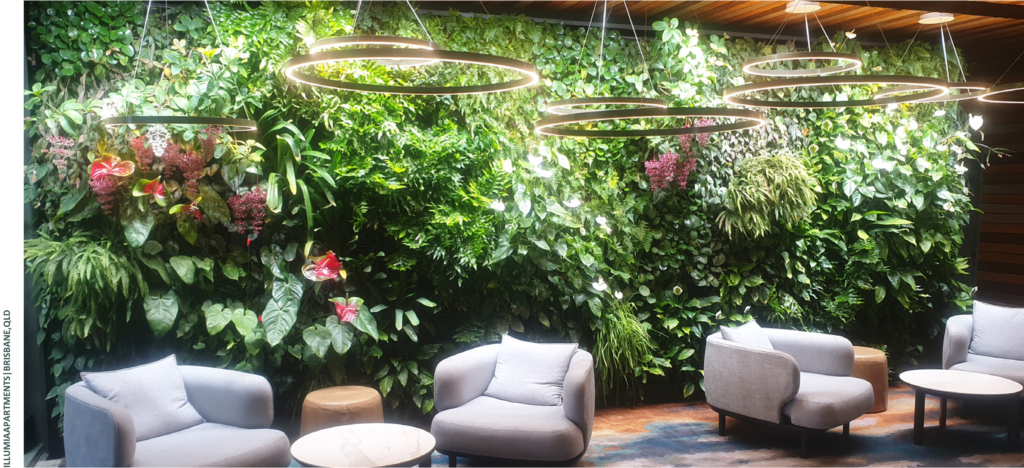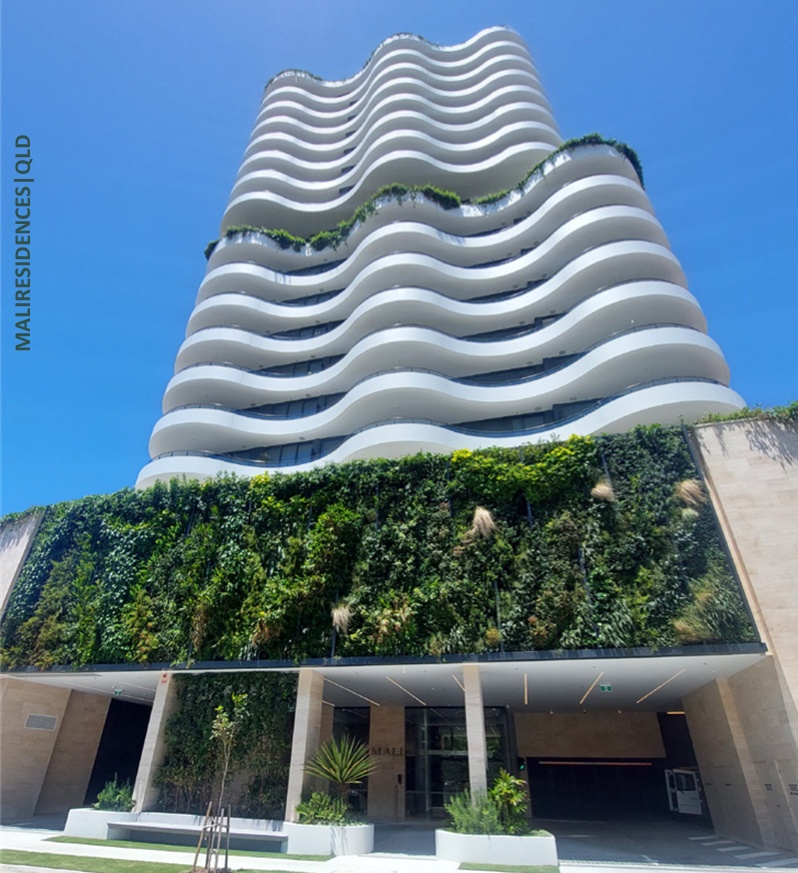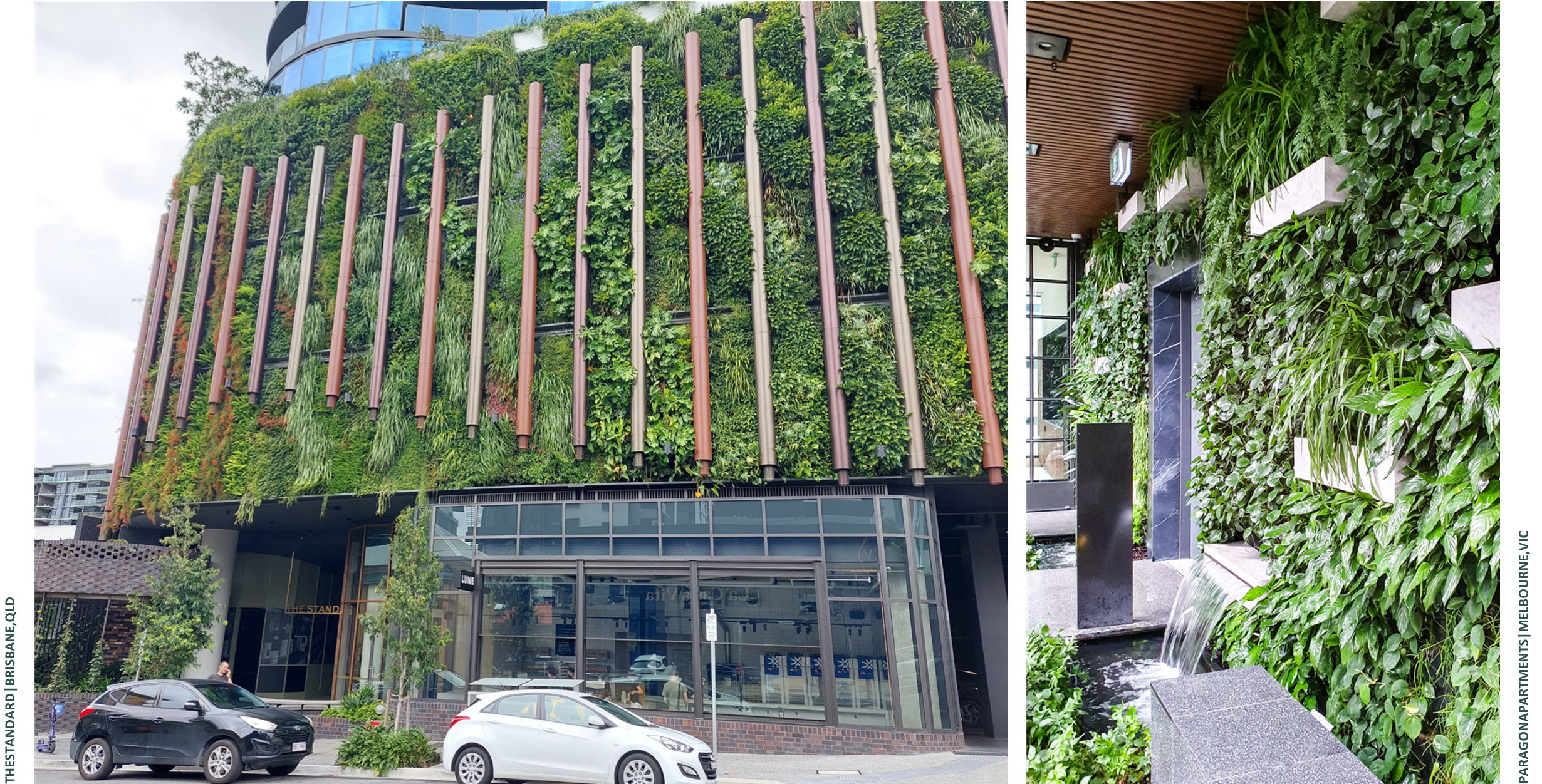Observing vertical gardens, we are frequently immersed in those aspects of gardens which are immediately observable, notably foliage, planting densities and the often-dramatic contrast between the hard, smooth, built environment and the lush, complex, textures, and movement provided by vegetation: Vertical Garden Biodiversity.
What the eye sees often belies the complexity and multidimensionality of what lies beneath such technologies. Gardens on the vertical plane are specialized and multi-functional, offering high carrying capacities for species, notably those transcending the simplicity of pots on a wall.
Vertical garden technologies have evolved into significantly refined and complex systems utilized to fulfill specialized functions relating to the architecture, function, and engineering requirements of contemporary buildings.
Heating, cooling, pollution stripping, wind management, sound attenuation, water processing, and habitat production represent initial functionalities required to be provided and expanded upon.
Delivering the above mentioned functions starts with the technologies hardware, though extends well beyond this to the principal host technology such installations are designed and built to support: vegetation.
“Embracing diversity in vertical gardens is a requirement as we place ever greater demands upon our installations.”
Plants are a technology, ecology (the combination of a plethora species functioning together as a dynamic whole) is an extension of plants as technologies. Plants have evolved, over millions of years, to generate highly refined capacities and tolerances to cope with very specific exposures. Plants on the exterior of a building, whether wrapped around a building wall or scaling a skyscraper to notable heights where winds and turbulence and even temperature fluctuations may be harsh, are certainly niches which seem extraordinary.
Each exposure type may be dramatically different, transitioning from permanent full shade to permanent full sun over a space of mere centimeters, inclusive of high wind shear, buffeting, reflected heat, dry winds to walls functioning as storm barriers.
Our cities are no different to mountains and natural features; they are often constructed from concrete, ground-up rock, melted sands into glass, metals and natural materials. Our city streets are constructed urban canyons, our buildings are cliff faces poised to be colonized by species specialized to access and grow on the vertical plane, often elevated to great heights and in shallow or almost non-existent substrates.
Here enters the mystery and complexity of aerial ecologies. Around the world, we find species colonizing trees and cliff faces encompassing all the aforementioned exposure-types and variations.

Each exposure type is colonized by specific species, many of which are not tolerant of variations to such exposures; many are specialized to cope with a niche that is small, yet encircled by vastly different combinations of exposures. These complex plant assemblages, the isolated specimens they comprise and the mixed species colonies they eventually expand into, both slowly start changing the conditions they are found in and on. When a plant arrives, it brings a modicum of change, a bit of shading, some wind protection, a little moisture capture and the slow accumulation of old leaves and plants, which invariably start decomposing into aerial soils. Many such soils are blown away, though some tenacious roots and leaves may hold onto it, with the mixture of living and decomposing materials evolving into living soils and substrates into which new species may arrive.
Each new arrival increases vegetation density, competition, protection, moisture capture, and nutrient release. This is a highly complex process of accumulation, life and death and development as the complexities of the aerial ecologies expand.
It is inevitable that the conditions initially encountered become changed. If this was a bare wall on a building, it would transition from being exposed, heated, dried and barren, to shaded, cooled, moistened and verdant with life. Pollution captured by leaves, roots, and microbes becomes a layer of food for the living wall. Acid rain is captured, and dust, exhaust fumes, salts in water, chlorine and other mainstay components of high density human habitats become resources the aerial ecologies may capitalize upon.
For this process to start, settle, strengthen, respond, specialize, and accumulate, it requires highly detailed species selection processes and considerations. Designing to achieve these unfolding processes requires highly specialized design skills and ecological understanding. It is an exciting field to be working in with each city, climate-type, and building architecture, requiring a different type and subset of plant community to cater for the vastly different exposure types inherent to our built environments.
 Consequently, there is a requirement to use plants not as things we regard in terms of merely their aesthetic, shape, form, colour and texture, rather as technologies.
Consequently, there is a requirement to use plants not as things we regard in terms of merely their aesthetic, shape, form, colour and texture, rather as technologies.
Each species represents an evolved technological achievement having originated in a different part of the world, within unique environments, competing with specific neighbouring species, and seeking to achieve a unique evolutionary outcome to successfully maintain survival and responsiveness to its particular life story. This life story is unfolding, never completed.
Utilizing high species diversity allows the designer (and the garden) to be responsive to site, clients’ varying needs, and to generate outcomes capable of being dynamic, potentially self-repairing, capable of reconfiguring and adjusting balances within the often harsh and changing constructed environment.
Diversity is not merely a design decision or aesthetic treatment, it is a technological application. A diverse ecology may be capable of generating resiliency. Low diversity places heightened stress and expectation upon a few species to perform multiple roles and tasks, thus higher diversity allows for the distribution of stressors and external pressures over the community as a whole, thereby reducing individual stress loadings and aiding individual specimens and communities to function more freely.
There are many hidden mysteries, complexities, and capabilities within diverse environments and ecologies which we are barely capable of conceiving, observing, or understanding. As we unfold the layers of species stratification in habitats and plant communities within the build environment, inclusive of those right under our noses, we frequently discover surprising and highly functional processes working towards generating balance and resiliency, which we were unto this point completely unaware.
Embracing diversity in vertical gardens is a requirement as we place ever greater demands upon our installations, expecting beauty, lower maintenance requirements, reduced resource input reliance, and higher tolerances all at a lower price to the consumer. Increased diversity becomes a vital component of achieving such outcomes.
Nature and nurture are amusingly synonymous in this context, with diverse ecologies becoming a trait of elegant simplicity at its highest level.
~ Erik van Zuilekom

Erik van Zuilekom is Fytogreen’s in-house Botanist and a species selection & design specialist – vertical garden & living architecture applications. Offering astute design & assessment expertise for the production of adaptive, robust & resilient (designed) ecologies. I would like to see green life ecologies deeply integrated into the urban fabric & psyche, not as passive claddings, rather as responsive technologies.
Fytogreen is Australia’s leading green infrastructure specialist and technical knowledge is gained from its targeted research and development process. Fytogreen is fortunate to be a leader in this field, with experience gained through exposure to an extensive diversity of applications, coupled with long-term monitoring of these installations.
Follow Erik on Instagram – United Natures Design
If you have a specific topic your would like covered by Erik or have any comments, please email lisa@fytogreen.com.au
 Greenroofs.comConnecting the Planet + Living Architecture
Greenroofs.comConnecting the Planet + Living Architecture









